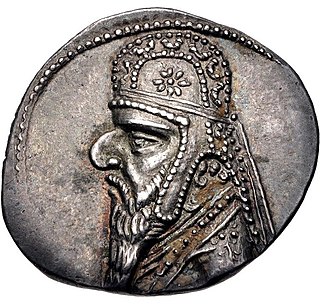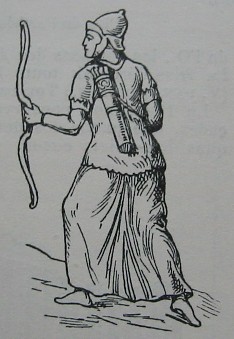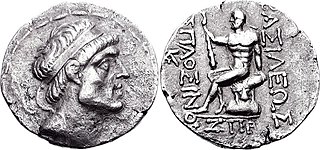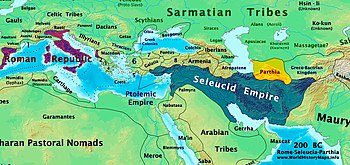In 245 BC, Andragoras, the Seleucid governor (satrap) of Parthia ("roughly western Khurasan" [1] ) proclaimed independence from the Seleucids, when - following the death of Antiochus II - Ptolemy III seized control of the Seleucid capital at Antioch, and "so left the future of the Seleucid dynasty for a moment in question." [2]
Meanwhile, "a man called Arsaces, of Scythian or Bactrian [a] origin, [was] elected leader of the Parni tribes." [3] Following the secession of Parthia from the Seleucid Empire and the resultant loss of Seleucid military support, Andragoras had difficulty in maintaining his borders, and about 238 BCE—under the command of "Arsaces and his brother Tiridates" [3] [4] —the Parni invaded [5] Parthia and seized control of Astabene (Astawa), the northern region of that territory, the administrative capital of which was Kabuchan (Kuchan in the vulgate).
A short while later the Parni seized the rest of Parthia from Andragoras, killing him in the process.

Mithridates II was king of the Parthian Empire from 124 to 91 BC. Considered one of the greatest of his dynasty to ever rule, he was known as Mithridates the Great in antiquity.

Arsaces I was the first king of Parthia, ruling from 247 BC to 217 BC, as well as the founder and eponym of the Arsacid dynasty of Parthia. The leader of the Parni, one of the three tribes of the Dahae confederacy, Arsaces founded his dynasty in the mid-3rd century BC when he conquered the satrapy of Parthia from Andragoras, who had rebelled against the Seleucid Empire. He spent the rest of his reign consolidating his rule in the region, and successfully stopped the Seleucid efforts to reconquer Parthia. Due to Arsaces' achievements, he became a popular figure amongst the Arsacid monarchs, who used his name as a royal honorific. By the time of his death, Arsaces had laid the foundations of a strong state, which would eventually transform into an empire under his great-grandnephew, Mithridates I, who assumed the ancient Near Eastern royal title of King of Kings. Arsaces was succeeded by his son Arsaces II.

The Parni, Aparni or Parnians were an East Iranian people who lived around the Ochus (Tejen) River, southeast of the Caspian Sea. It is believed that their original homeland may have been what is now southern Russia, from where they emigrated with other Scythian tribes. The Parni were one of the three tribes of the Dahae confederacy.

Hyrcania is a historical region composed of the land south-east of the Caspian Sea in modern-day Iran and Turkmenistan, bound in the south by the Alborz mountain range and the Kopet Dag in the east.

Mithridates I, also known as Mithridates I the Great, was king of the Parthian Empire from 165 BC to 132 BC. During his reign, Parthia was transformed from a small kingdom into a major political power in the Ancient East as a result of his conquests. He first conquered Aria, Margiana and western Bactria from the Greco-Bactrians sometime in 163–155 BC, and then waged war with the Seleucid Empire, conquering Media and Atropatene in 148/7 BC. In 141 BC, he conquered Babylonia and held an official investiture ceremony in Seleucia. The kingdoms of Elymais and Characene shortly afterwards became Parthian vassals. In c. 140 BC, while Mithridates was fighting the nomadic Saka in the east, the Seleucid king Demetrius II Nicator attempted to regain the lost territories; initially successful, he was defeated and captured in 138 BC, and shortly afterwards sent to one of Mithridates I's palaces in Hyrcania. Mithridates I then punished Elymais for aiding Demetrius, and made Persis a Parthian vassal.

Phraates II was king of the Parthian Empire from 132 BC to 127 BC. He was the son and successor of Mithridates I.

Mithridates IV was a Parthian king from to 57 to 54 BC. He was the son and successor of Phraates III. Mithridates IV's reign was marked by a dynastic struggle with his younger brother, Orodes II, who eventually emerged victorious and had Mithridates IV executed, thus succeeding him.

Pacorus I was a Parthian prince, who was the son and heir of Orodes II. The numismatist David Sellwood deduced that Pacorus ruled in c. 39 BC. It is uncertain whether Pacorus ruled alongside his father, or ruled independently. His wife was an unnamed Armenian princess, who was a sister of the Artaxiad king of Armenia, Artavasdes II.

Vonones I was an Arsacid prince, who ruled as King of Kings of Parthian Empire from 8 to 12, and then subsequently as king of Armenia from 12 to 18. He was the eldest son of Phraates IV and was sent to Rome as a hostage in 10/9 BC in order to prevent conflict over the succession of Phraates IV's youngest son, Phraataces.

Vardanes I was a king of the Parthian Empire from 40 to 46 AD. He was the heir apparent of his father Artabanus II, but had to continually fight against his brother Gotarzes II, a rival claimant to the throne. Vardanes' short reign ended when he was assassinated while hunting at the instigation of a party of Parthian nobles.

Gotarzes II was king of the Parthian Empire from 40 to 51. He was an adopted son of Artabanus II. When his father died in 40, his brother Vardanes I was to succeed to the throne. However, the throne was seized by Gotarzes II. Gotarzes II eventually was able to gain control of most of Parthia forcing Vardanes to flee to Bactria. With the death of Vardanes in c. 46, Gotarzes II ruled the Parthian Empire until his death. Gotarzes II was succeeded by his uncle Vonones II.

Arsaces II, was the Arsacid king of Parthia from 217 BC to 191 BC.

Vologases IV was King of Kings of the Parthian Empire from 147 to 191. He was the son of Mithridates V. Vologases spent the early years of his reign re-asserting Parthian control over the Kingdom of Characene. From 161 to 166, he waged war against the Roman Empire; although initially successful, conquering Armenia and Syria, he was eventually pushed back, briefly losing control of the Parthian capitals of Seleucia and Ctesiphon to the Romans. The Romans suffered heavy losses from a plague erupting from Seleucia in 166, forcing them to withdraw. The war ended soon afterward, with Vologases losing most of northern Mesopotamia to the Romans. He died in 191 and was succeeded by his son Vologases V.
The Battle of Ecbatana was fought in 129 BC between the Seleucids led by Antiochus VII Sidetes and the Parthians led by Phraates II, and marked the final attempt on the part of the Seleucids to regain their power in the east against the Parthians. After their defeat, the territory of the Seleucids was limited to the area of Syria.

The Parthian Empire, also known as the Arsacid Empire, was a major Iranian political and cultural power in ancient Iran from 247 BC to 224 AD. Its latter name comes from its founder, Arsaces I, who led the Parni tribe in conquering the region of Parthia in Iran's northeast, then a satrapy (province) under Andragoras, who was rebelling against the Seleucid Empire. Mithridates I greatly expanded the empire by seizing Media and Mesopotamia from the Seleucids. At its height, the Parthian Empire stretched from the northern reaches of the Euphrates, in what is now central-eastern Turkey, to present-day Afghanistan and western Pakistan. The empire, located on the Silk Road trade route between the Roman Empire in the Mediterranean Basin and the Han dynasty of China, became a center of trade and commerce.

Andragoras was an Iranian satrap of the Seleucid provinces of Parthia and Hyrcania under the Seleucid rulers Antiochus I Soter and Antiochus II Theos. He later revolted against his overlords, ruling independently from 245 BC till his death.

Parthia is a historical region located in northeastern Greater Iran. It was conquered and subjugated by the empire of the Medes during the 7th century BC, was incorporated into the subsequent Achaemenid Empire under Cyrus the Great in the 6th century BC, and formed part of the Hellenistic Seleucid Empire after the 4th-century BC conquests of Alexander the Great. The region later served as the political and cultural base of the Eastern Iranian Parni people and Arsacid dynasty, rulers of the Parthian Empire. The Sasanian Empire, the last state of pre-Islamic Iran, also held the region and maintained the seven Parthian clans as part of their feudal aristocracy.

The Seleucid–Parthian wars were a series of conflicts between the Seleucid Empire and the Parthian Empire which resulted in the ultimate expulsion of the Seleucids from the Iranian Plateau and the surrounding regions. The wars were caused by the mass migration of the nomadic Iranian Parni tribe into Parthia and the establishment of the Parthian state, which challenged Seleucid hegemony.

Hyspaosines was an Iranian prince, and the founder of Characene, a kingdom situated in southern Mesopotamia. He was originally a Seleucid satrap installed by king Antiochus IV Epiphanes, but declared independence in 141 BC after the collapse and subsequent transfer of Seleucid authority in Iran and Babylonia to the Parthians. Hyspaosines briefly occupied the Parthian city of Babylon in 127 BC, where he is recorded in records as king (šarru). In 124 BC, however, he was forced to acknowledge Parthian suzerainty. He died in the same year, and was succeeded by his juvenile son Apodakos.
Phraates was a Parthian prince, who was one of the eldest sons of Phraates IV.


















